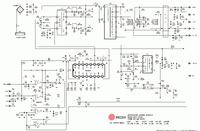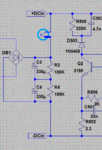kkeeley
Member level 3

Hi,
Sorry if this is a long post.
Overview:
I am working on a project where by I am rebuilding an existing working PC ATX power supply onto a new PCB so that the power supply can fit into the main unit of my overall project.
I have spent many days/weeks studying the existing circuit and drawing it in LTspice. I have also managed to find a schematic on the Web that is an exact match to the circuit I'm copying.
What I've Done so far:
I decided that rather than building the entire circuit first I would just build the input recifiers and the +5V standby circuits. As seen in the attached image. LTspice shows this diagram to work and produce voltages. As I didn't wind the transformer myself I have had to guess/Play with the figures for the inductance of the inductors. I attached a red LED and 330R resistor to the +5V circuit and a 12V 50mA fan to the Aux circuit.

First attempt:
The first time I applied power to the circuit the led glowed and the fan ran (all was looking good), shortly after this both transistors and a few resistors self destructed in smoke. After removing all the visiblly damaged parts I found that the resistor I had use for R502 was an 18K instead of the 2R2. I replaced both Transistors and all resistors and caps on the high voltage side.
Current State of play:
After trying the circuit again the transistors went up in smoke again. At this point I replaced all parts on the high voltage side except for the transformer, which I didn't make as it is the one from the original circuit. Now the circuit no longer produces any output voltage and the fuse and other parts are not going up in smoke.
My Question:
As there are some rather high voltages involed in this circuit I would like to know firstly what might be the root cause of my problem? Are there any ways to lower the input voltage to a safer level and still have a working circuit? Can I test smaller parts of the circuit? Like checking that the transistors are oscilating as expected to product the AC voltage required on the transformer, etc.
Thanks for any help offered.
Kenneth
Sorry if this is a long post.
Overview:
I am working on a project where by I am rebuilding an existing working PC ATX power supply onto a new PCB so that the power supply can fit into the main unit of my overall project.
I have spent many days/weeks studying the existing circuit and drawing it in LTspice. I have also managed to find a schematic on the Web that is an exact match to the circuit I'm copying.
What I've Done so far:
I decided that rather than building the entire circuit first I would just build the input recifiers and the +5V standby circuits. As seen in the attached image. LTspice shows this diagram to work and produce voltages. As I didn't wind the transformer myself I have had to guess/Play with the figures for the inductance of the inductors. I attached a red LED and 330R resistor to the +5V circuit and a 12V 50mA fan to the Aux circuit.

First attempt:
The first time I applied power to the circuit the led glowed and the fan ran (all was looking good), shortly after this both transistors and a few resistors self destructed in smoke. After removing all the visiblly damaged parts I found that the resistor I had use for R502 was an 18K instead of the 2R2. I replaced both Transistors and all resistors and caps on the high voltage side.
Current State of play:
After trying the circuit again the transistors went up in smoke again. At this point I replaced all parts on the high voltage side except for the transformer, which I didn't make as it is the one from the original circuit. Now the circuit no longer produces any output voltage and the fuse and other parts are not going up in smoke.
My Question:
As there are some rather high voltages involed in this circuit I would like to know firstly what might be the root cause of my problem? Are there any ways to lower the input voltage to a safer level and still have a working circuit? Can I test smaller parts of the circuit? Like checking that the transistors are oscilating as expected to product the AC voltage required on the transformer, etc.
Thanks for any help offered.
Kenneth





